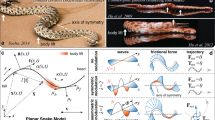Abstract
Snakes are able to dynamically change their frictional interactions with a surface by at least three different methods: (1) adjusting the attitude of their scales, (2) redistributing their weight at various points of contact with the substrate, and (3) changing of their winding angles. In the present study, we have observed that snakes change their winding angles, when either friction anisotropy is suppressed by particular roughness of the substrate, or when the external force displacing snake overcomes friction resistance during their locomotion on inclines. In order to understand this behaviour and may be even to predict the specific way of the snake locomotion depending on the interactions between the ventral surface of the snake skin and the substrate, numerical modelling was undertaken. Adaptation of the winding curvature considered in the present study has something to do with an enhancement of friction anisotropy in critical behavioural situations, such as on low-friction substrates or while moving up and down a slope.





Similar content being viewed by others
References
Abdel-Aal, H.A., Vargiolu, R., Zahouani, H., El Mansori, M.: Preliminary investigation of the frictional response of reptilian shed skin. Wear. 290–291, 51–60 (2012)
Abdel-Aal, H.A.: Surface structure and tribology of legless squamate reptiles. J Mech Behav Biomed Mat. 79, 354–398 (2018). https://doi.org/10.1016/j.jmbbm.2017.11.008
Alben, S.: Optimizing snake locomotion in the plane. Proc R Soc A. 469, 20130236 (2013). https://doi.org/10.1098/rspa.2013.0236
Baum, M.J., Kovalev, A.K., Michels, J., Gorb, S.N.: Anisotropic friction of the ventral scales in the snake Lampropeltis getula californiae. Tribol Lett. 54(2), 139–150 (2014). https://doi.org/10.1007/s11249-014-0319-y
Berthé, R.A., Westhoff, G., Bleckmann, H., Gorb, S.N.: Surface structure and frictional properties of the Amazon tree boa Corallus hortulanus (Squamata, Boidae). J Comp Physiol A. 195, 311–318 (2009)
Bowden, F.P., Tabor, D.: The friction and lubrication of solids. Clarendon Press, Wotton-under-Edge (1986)
Chiasson, R.B., Lowe, C.H.: Ultrastructural scale patterns in Nerodia and Thamnophis. J Herpetol. 23, 109–118 (1989)
Filippov, A., Gorb, S.N.: Frictional-anisotropy-based systems in biology: structural diversity and numerical model. Sci Rep. 3, 1240 (2013). https://doi.org/10.1038/srep01240
Filippov, A.E., Gorb, S.N.: Modelling of the frictional behaviour of the snake skin covered by anisotropic surface nanostructures. Sci Rep. 6, 23539 (2016). https://doi.org/10.1038/srep23539
Gans, C.: Slide-pushing: a transitional locomotor method of elongate squamates. Symp Zool Soc Lond. 52, 12–26 (1984)
Gower, D.J.: Scale microornamentation of uropeltid snakes. J Morphol. 258, 249–268 (2003)
Hazel, J., Stone, M., Grace, M.S., Tsukruk, V.V.: Nanoscale design of snake skin for reptation locomotions via friction anisotropy. J. Biomech. 32, 477–484 (1999)
Hoge, A.R., Santos, P.S.: Submicroscopic structure of “stratum corneum” of snakes. Science. 118, 410–411 (1953)
Hu, L.D., Nirody, J., Scott, T., Shelley, M.J.: The mechanics of slithering locomotion. Proc Natl Acad Sci USA. 106, 10081–10085 (2009)
Irish, F.J., Williams, E.E., Seling, E.: Scanning electron microscopy of changes in epidermal structure occurring during the shedding cycle in squamate reptiles. J Morphol. 197, 105–126 (1988)
Jayne, B.C.: Kinematics of terrestrial snake locomotion. Copeia. 22, 915–927 (1986)
Maderson, P.F.A.: When? why? and how? Some speculations on the evolution of the vertebrate integument. Am Zool. 12, 159–171 (1972)
Marvi, H., Hu, D.L.: Friction enhancement in concertina locomotion of snakes. J R Soc Interface. 9–76, 3067–3080 (2012)
Picado, C.: Epidermal microornaments of the Crotalinae. Bull Antivenin Inst Am. 4, 104–105 (1931)
Price, R.M.: Dorsal snake scale microdermatoglyphics: ecological indicator or taxonomic tool? J Herpetol. 16, 294–306 (1982)
Price, R.M., Kelly, P.: Microdermatoglyphics: basal patterns and transition zones. J Herpetol 23, 244–261 (1989)
Renous, S., Gasc, J.P., Diop, A.: Microstructure of the tegumentary surface of the Squamata (Reptilia) in relation to their spatial position and their locomotion. Fortschr Zool. 30, 487–489 (1985)
Scherge, M., Gorb, S.N.: Biological micro- and nanotribology. Springer, New York (2001)
Schmidt, C.V., Gorb, S.N.: Snake scale microstructure: phylogenetic significance and functional adaptations. Schweizerbart Science Publisher, Stuttgart (2012)
Wang, X., Osborne, M.T., Alben, S.: Optimizing snake locomotion on an inclined plane. Phys Rev E. 89, 012717 (2014)
Acknowledgements
This work was partly supported by the Georg Forster Research Award (Alexander von Humboldt Foundation, Germany) to A.E.F. The preparation of this paper was partly supported by the Leverhulme Trust (project CARBTRIB ‘Nanophenomena and functionality of modern carbon-based tribo-coatings’).
Author information
Authors and Affiliations
Corresponding author
Electronic supplementary material
Below is the link to the electronic supplementary material.
Supplementary material 1 (FLV 5876 KB)
Rights and permissions
About this article
Cite this article
Filippov, A.E., Westhoff, G., Kovalev, A. et al. Numerical Model of the Slithering Snake Locomotion Based on the Friction Anisotropy of the Ventral Skin. Tribol Lett 66, 119 (2018). https://doi.org/10.1007/s11249-018-1072-4
Received:
Accepted:
Published:
DOI: https://doi.org/10.1007/s11249-018-1072-4




